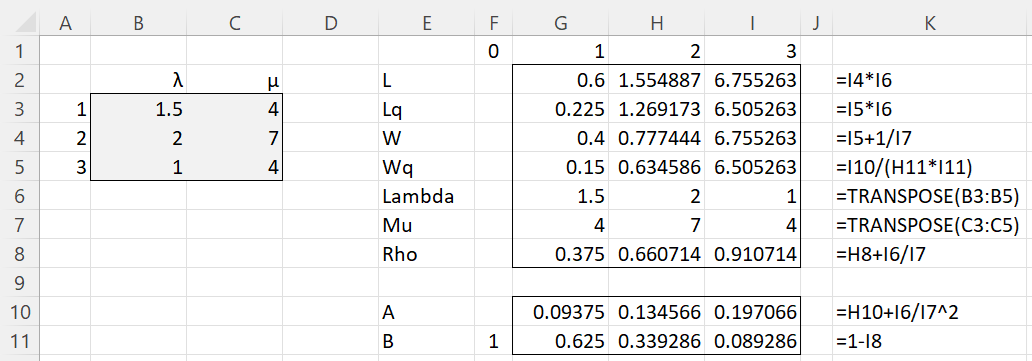Basic Concepts
We now consider the M/M/1 model with non-preemptive priority queueing, except that now the service rates for the priority classes can vary. The mean service rate for the kth priority class is μk (and the arrival rate is λk).
Properties
We suppose that we have m priority classes where class 1 is of higher priority than class 2, etc. Using the notation from Queueing Theory, for k = 1, 2, …, m, the mean queueing time for customers from priority class k is
where
As usual, the mean time that customers from priority class k remain in the system is
By Little’s Law
The above formulas hold when the system reaches a steady state, which is applicable when
Example
Example 1: Calculate L, Lq, W, and Wq for the M/M/1 queueing model with three priority classes where the arrival rates and the service rate are as described in columns B and C of Figure 1.
The results are shown on the right side of Figure 1. Column K displays the formulas in column I.
Figure 1 – M/M/1 with non-preemptive priority queueing
Worksheet Functions
Excel Functions: The Real Statistics Resource Pack supports the following array function. Here, R1 is a row or column array or cell range that contains the arrival rates for the various priority classes. R2 is a row or column array or cell range that contains the service rates for the various priority classes.
MM1PS(R1, R2, lab): returns an array with L, Lq, W, Wq, ρ for each priority class in an M/M/1 non-preemptive priority queueing model.
If lab = TRUE (default FALSE) then an extra column of labels is appended to the output.
You can obtain the values in Figure 1 via the array formula
=MM1PS(B3:B5,C3:C5,TRUE)
Examples Workbook
Click here to download the Excel workbook with the examples described on this webpage.
References
Ross, S. M. (2014) Introduction to probability models, 11th Ed. Academic Press
https://ebin.pub/introduction-to-probability-models-11nbsped-0124079482-9780124079489.html
Sztrik, J. (2021) Basic queueing theory
https://irh.inf.unideb.hu/~jsztrik/education/16/SOR_Main_Angol.pdf
Shores, T. S. (2017) Queueing theory basics and models
No longer available online
Hillier, F. S., Lieberman, G. J. (2010) Introduction to operations research. 9th Ed.
